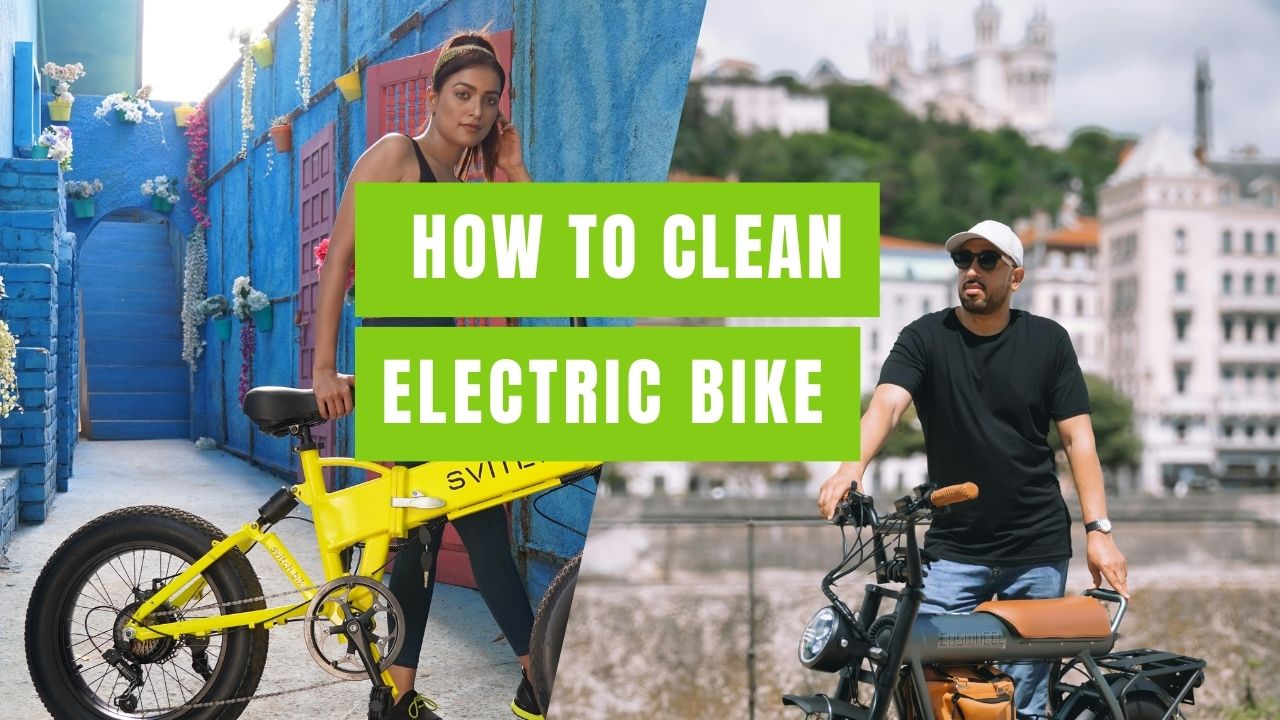Maintaining a clean electric bike (e-bike) is essential for its performance, durability, and overall appearance. Regular cleaning prevents dirt and grime from causing mechanical issues and helps keep your bike running smoothly. This step-by-step guide will walk you through the process of cleaning your e-bike thoroughly and safely.
1. Gather Your Cleaning Supplies
Materials Needed:
- Water Source: Use a garden hose with a gentle spray or a bucket of water. High-pressure water can damage the bike’s components.
- Mild Detergent: Opt for a bike-specific cleaner or mild dish soap to avoid harsh chemicals that could harm the bike’s finish.
- Soft Brushes: Various sizes of soft-bristled brushes will help you clean different parts of the bike without scratching it.
- Sponges and Cloths: Microfiber cloths are ideal for drying and polishing. Have a few on hand for different stages of the cleaning process.
- Chain Cleaner: A dedicated chain cleaning tool or a stiff brush to clean the chain effectively.
- Chain Lubricant: After cleaning, a suitable bike chain lubricant will keep the chain running smoothly.
Explanation: Having the right tools and materials ready ensures an efficient and thorough cleaning process. Using gentle, bike-specific products protects the bike’s components from damage.
2. Prepare the Bike
Steps:
- Turn Off the Battery: Ensure the bike is powered off to avoid any electrical issues during cleaning.
- Remove the Battery: If your bike allows, remove the battery and store it in a safe, dry place. This prevents water damage and makes the bike easier to handle.
- Position the Bike: Use a bike stand to elevate the bike, giving you better access to all parts. If you don’t have a stand, you can lean the bike against a wall or lay it down carefully.
Explanation: Preparing the bike properly protects the electrical components and makes the cleaning process more manageable. Removing the battery ensures safety and prevents water from seeping into sensitive areas.
3. Rinse the Bike
Steps:
- Gentle Spray: Use a hose with a gentle spray setting to rinse off loose dirt and debris. Avoid using high-pressure water as it can damage the bike’s electrical components and bearings.
- Careful Around Electronics: Be cautious around the motor, battery mount, and display. Avoid direct water spray on these areas to prevent damage.
Explanation: Rinsing the bike initially removes surface dirt, making the subsequent cleaning steps more effective. Gentle spraying protects the bike’s sensitive parts from water damage.
4. Clean the Frame and Components
Steps:
- Apply Cleaner: Spray the bike-specific cleaner or mild detergent solution onto the frame and components.
- Brush and Sponge: Use soft brushes and sponges to scrub the frame, wheels, and other parts. Focus on areas with accumulated dirt, such as the bottom bracket, fork, and behind the crankset.
- Rinse Again: Gently rinse off the soap and dirt. Ensure no cleaner residue is left behind, especially on the brakes and gears.
Explanation: Using the right cleaning agents and tools ensures the bike’s components are thoroughly cleaned without being damaged. Paying attention to detailed areas helps maintain the bike’s overall performance and appearance.
5. Clean the Chain and Drivetrain
Steps:
- Apply Chain Cleaner: Use a chain cleaning tool or brush to apply the cleaner to the chain. Rotate the pedals backward to distribute the cleaner evenly.
- Scrub the Chain: Continue rotating the pedals while scrubbing the chain thoroughly with the brush or cleaning tool.
- Rinse and Dry: Rinse the chain and drivetrain components with water, then dry them with a clean cloth to prevent rust.
Explanation: A clean chain and drivetrain are crucial for efficient bike performance. Removing dirt and old lubricant reduces wear and tear on these components, ensuring a smoother ride.
6. Dry the Bike
Steps:
- Use a Microfiber Cloth: Dry the entire bike with a microfiber cloth, paying extra attention to metal parts to prevent rust.
- Air Dry: Allow the bike to air dry for a while to ensure all moisture is gone, especially in hard-to-reach areas.
Explanation: Drying the bike thoroughly prevents rust and corrosion. Using a microfiber cloth is gentle on the bike’s surfaces and effective in absorbing moisture.
7. Lubricate the Chain
Steps:
- Apply Lubricant: Apply a suitable bike chain lubricant evenly to the chain while rotating the pedals backward. Ensure the lubricant penetrates all the links.
- Wipe Excess: Wipe off any excess lubricant with a clean cloth to prevent dirt attraction.
Explanation: Lubricating the chain after cleaning ensures it runs smoothly and reduces friction. Removing excess lubricant prevents dirt from sticking to the chain, extending its lifespan.
8. Reassemble and Check
Steps:
- Reattach the Battery: Once the bike is completely dry, reattach the battery securely.
- Check Components: Ensure all components, such as brakes, gears, and tires, are securely fastened and functioning properly before your next ride.
Explanation: Reassembling the bike correctly and checking all components ensures your safety and the bike’s performance. A thorough inspection helps identify any potential issues that may need attention.
9. Regular Maintenance Tips
Tips:
- Frequency: Clean your e-bike regularly, especially after riding in wet or muddy conditions, to prevent dirt buildup and corrosion.
- Inspect Parts: Regularly check for wear and tear on tires, brakes, and other components. Address any issues promptly to avoid costly repairs.
- Professional Service: Schedule professional maintenance periodically to keep your e-bike in optimal condition. A professional can spot and fix problems you might miss.
Explanation: Regular maintenance extends the life of your e-bike and ensures it remains safe and enjoyable to ride. Addressing issues early prevents minor problems from becoming major ones.
Conclusion
Cleaning your electric bike is a straightforward yet crucial task that significantly contributes to its performance and longevity. By following these detailed steps, you can maintain your e-bike in excellent condition, ensuring a smooth and enjoyable riding experience. Regular cleaning and maintenance not only keep your bike looking great but also prevent potential mechanical issues, allowing you to ride with confidence.
FAQ: How to Clean Your Electric Bike
Q1: How often should I clean my electric bike? A1: It’s best to clean your electric bike after every few rides, especially if you ride in wet or muddy conditions. Regular cleaning helps prevent dirt buildup and prolongs the life of your bike’s components.
Q2: Can I use a high-pressure washer to clean my e-bike? A2: No, avoid using high-pressure washers as they can force water into sensitive areas like the motor, battery, and bearings, causing damage. Use a gentle spray or a bucket of water instead.
Q3: What kind of detergent should I use? A3: Use a mild dish soap or a bike-specific cleaner. Harsh chemicals can damage the bike’s finish and components.
Q4: Is it necessary to remove the battery before cleaning? A4: Yes, if possible, remove the battery to prevent water from getting into the electrical connections. Always ensure the bike is powered off before cleaning.
Q5: How do I clean the chain and drivetrain? A5: Use a chain cleaner tool or a stiff brush to apply a bike-specific chain cleaner. Scrub thoroughly while rotating the pedals, rinse with water, and dry with a cloth. Don’t forget to lubricate the chain afterward.
Q6: Can I clean the e-bike’s electronic components? A6: Avoid direct water contact with electronic components like the motor, battery mount, and display. Wipe them with a damp cloth if necessary, but do not spray water directly on these areas.
Q7: How should I dry my e-bike after cleaning? A7: Use a microfiber cloth to dry the bike, especially metal parts, to prevent rust. Let the bike air dry completely before reattaching the battery and using it again.
Q8: What kind of lubricant should I use for the chain? A8: Use a bike-specific chain lubricant. Apply it evenly while rotating the pedals, then wipe off any excess to prevent dirt attraction.
Q9: How can I protect my e-bike from rust? A9: Regularly cleaning and thoroughly drying your e-bike, especially after wet rides, helps prevent rust. Applying a suitable lubricant to the chain and metal parts also provides protection.
Q10: Do I need to inspect my e-bike regularly? A10: Yes, regular inspections are crucial. Check for wear and tear on tires, brakes, and other components, and address any issues promptly to ensure safe and efficient riding.
Q11: Should I get professional maintenance for my e-bike? A11: Yes, scheduling professional maintenance periodically is a good idea. Professionals can spot and fix problems that you might miss, keeping your e-bike in optimal condition.
Feel free to use this FAQ section to address common concerns and questions about cleaning electric bikes. If you need more details or have other questions, let me know

